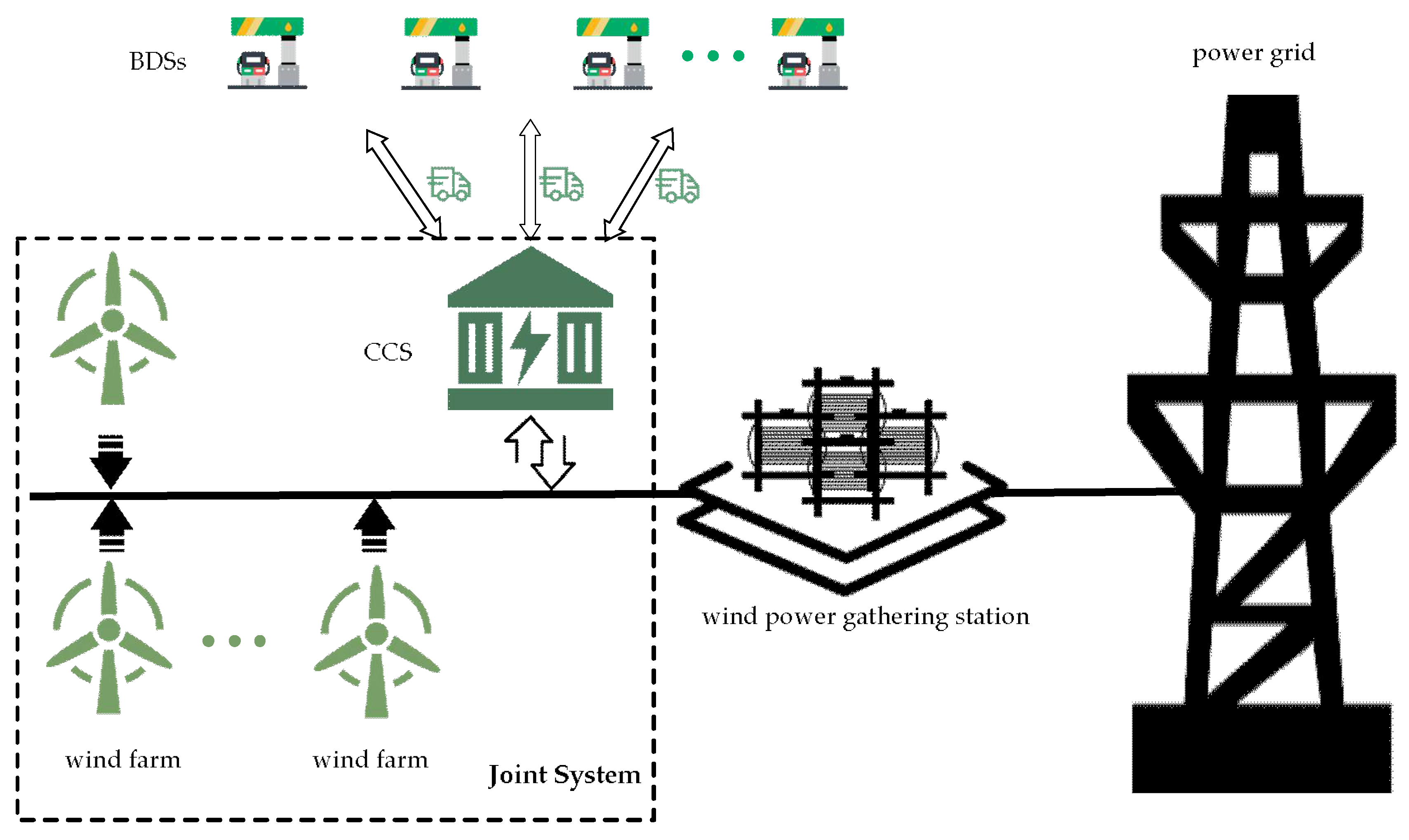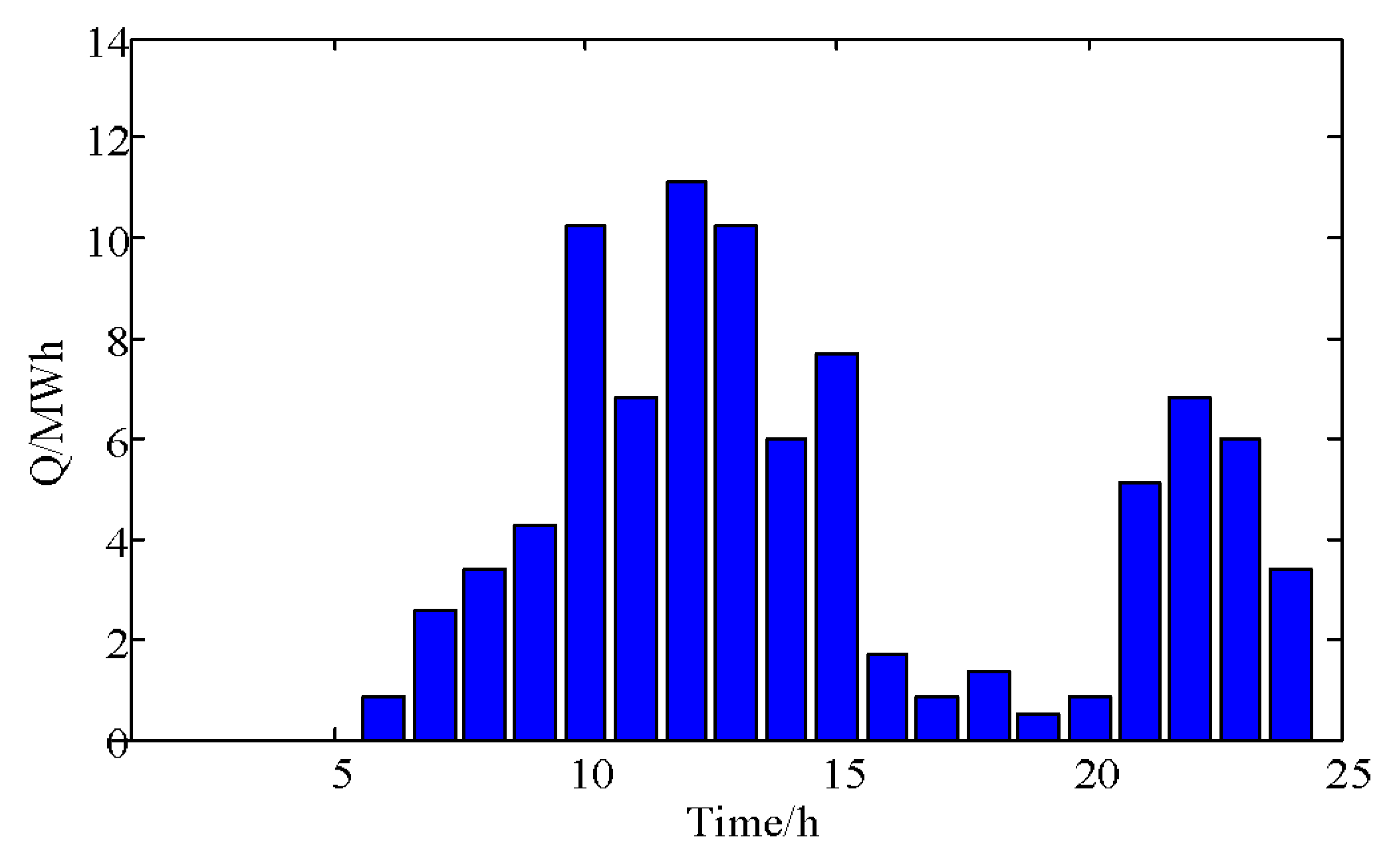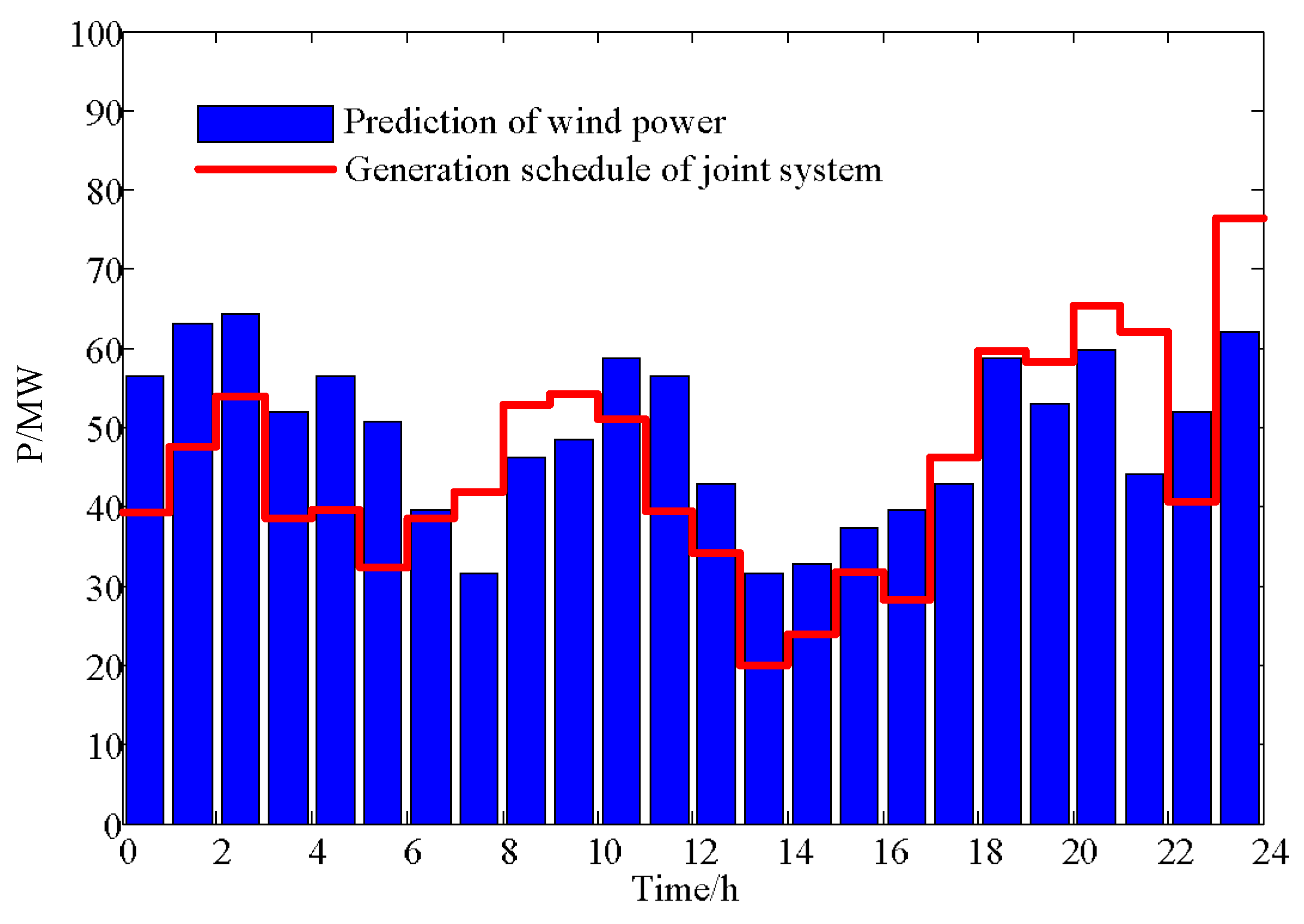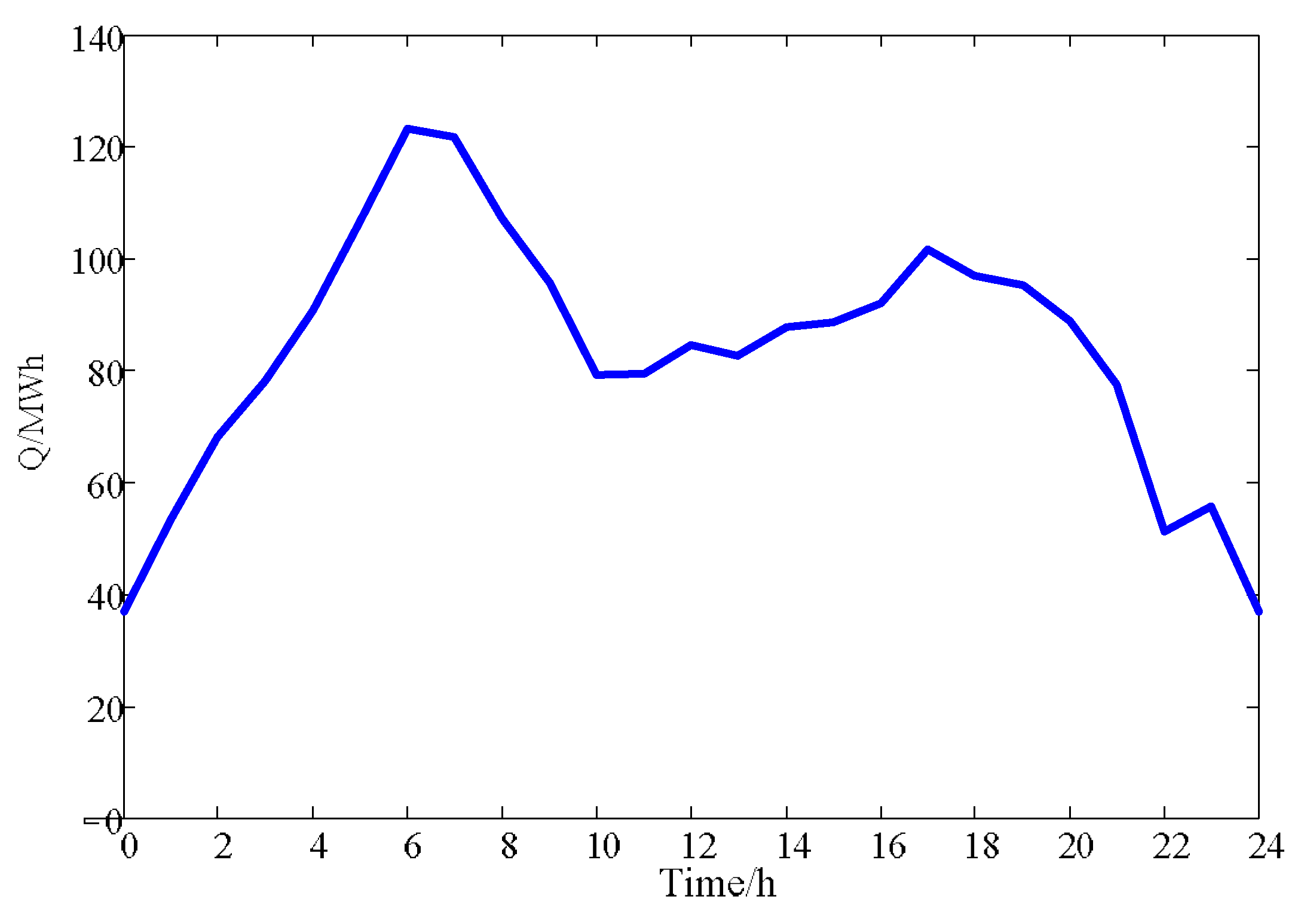Capacity Optimization of a Centralized Charging Station in Joint Operation with a Wind Farm
Abstract
:1. Introduction
2. Joint Operation of Wind Farm and CCS
2.1. The Battery Swapping Pattern of Centralized Charging and Unified Distribution
2.2. Joint Operation Pattern
2.3. Operating Indices of the Joint System
3. CCS Capacity Optimization Based on Dependent-Chance Goal Programming
3.1. Mathematical Modeling
3.2. A Solving Method Combining Monte Carlo Simulation and Genetic Algorithm (GA)
4. Simulation Analysis
4.1. Simulation Parameter Setting
4.2. Optimization Result Analysis
5. Conclusions
- (1)
- Joint operation of the CCS and the wind farm generates a benefit in coordination. On one hand, the CCS provides a standby capacity for the wind farm to improve controllability of wind power and to reduce economic penalties incurred by joint system power deviation. On the other hand, the CCS takes advantage of the wind power to charge batteries so that zero emission of EVs can be realized.
- (2)
- The joint system responds to the grid purchase price of wind power to further improve its electricity selling revenue. The capacity optimization model proposed in this paper comprehensively accounts for investment cost, wind power price, battery life, and other factors, and then the system weighs whether a principle of “charge when low and discharge if high” can be adopted so that the CCS will earn profits. On this basis, the optimal capacity of the CCS is determined, along with the optimal generation schedule of the joint system.
- (3)
- The generation schedule of the joint system is closely related to wind power price. The grid purchase price of the wind power should be rationally specified to effectively direct the output power of the joint system and to determine a win-win strategy between the power grid and the proposed joint system.
Author Contributions
Acknowledgments
Conflicts of Interest
References
- Basit, A.; Hansen, A.D.; Sørensen, P.E.; Giannopoulos, G. Real-time impact of power balancing on power system operation with large scale integration of wind power. J. Mod. Power Syst. Clean Energy 2017, 5, 202–210. [Google Scholar] [CrossRef]
- Le, H.T.; Santoso, S.; Nguyen, T.Q. Augmenting Wind Power Penetration and Grid Voltage Stability Limits Using ESS: Application Design, Sizing, and a Case Study. IEEE Trans. Power Syst. 2015, 27, 161–171. [Google Scholar] [CrossRef]
- Liu, G.; Tomsovic, K. Quantifying spinning reserve in systems with significant wind power penetration. IEEE Trans. Power Syst. 2012, 27, 2385–2393. [Google Scholar] [CrossRef]
- Smith, J.C.; Milligan, M.R.; Demeo, E.A.; Parsons, B. Utility Wind Integration and Operating Impact State of the Art. IEEE Trans. Power Syst. 2007, 22, 900–908. [Google Scholar] [CrossRef]
- Kim, C.; Muljadi, E.; Chung, C.C.; Sciubba, E. Coordinated Control of Wind Turbine and Energy Storage System for Reducing Wind Power Fluctuation. Energies 2017, 11, 52. [Google Scholar] [CrossRef]
- Wang, P.; Gao, Z.; Bertling, L. Operational Adequacy Studies of Power Systems with Wind Farms and Energy Storages. IEEE Trans. Power Syst. 2012, 27, 2377–2384. [Google Scholar] [CrossRef]
- Qin, M.; Chan, K.W.; Chi, Y.C.; Wu, T. Optimal planning and operation of energy storage systems in radial networks for wind power integration with reserve support. IET Gener. Transm. Distrib. 2016, 10, 2019–2025. [Google Scholar] [CrossRef]
- Zhao, J.; Wen, F.; Dong, Z.; Wong, K.P. Optimal Dispatch of Electric Vehicles and Wind Power Using Enhanced Particle Swarm Optimization. IEEE Trans. Ind. Inform. 2012, 8, 889–899. [Google Scholar] [CrossRef]
- Khodayar, M.E.; Wu, L.; Shahidehpour, M. Hourly Coordination of Electric Vehicle Operation and Volatile Wind Power Generation in SCUC. IEEE Trans. Smart Grid 2012, 3, 1271–1279. [Google Scholar] [CrossRef]
- Shao, C.; Wang, X.; Wang, X.; Du, C.; Dang, C.; Liu, S. Cooperative Dispatch of Wind Generation and Electric Vehicles with Battery Storage Capacity Constraints in SCUC. IEEE Trans. Smart Grid 2014, 5, 2219–2226. [Google Scholar] [CrossRef]
- Jiang, Z.; Han, X.; Li, Z.; Li, W.; Wang, M.; Wang, M. Two-Stage Multi-Objective Collaborative Scheduling for Wind Farm and Battery Switch Station. Energies 2016, 9, 886. [Google Scholar] [CrossRef]
- Luo, Z.; Hu, Z.; Song, Y.; Xu, Z.; Jia, L. Study on charging load modeling and coordinated charging of electric vehicles under battery swapping modes. Proc. CSEE 2012, 32, 1–10. [Google Scholar]
- Hübner, M.; Zhao, L.; Mirbach, T.; Haubrich, H.J.; Moser, A. Impact of large-scale electric vehicle application on the power supply. In Proceedings of the 2009 IEEE Electrical Power & Energy Conference (EPEC), Montreal, QC, Canada, 22–23 October 2009; pp. 1–6. [Google Scholar]
- Doucette, R.T.; McCulloch, M.D. Modeling the CO2 emissions from battery electric vehicles given the power generation mixes of different countries. Energy Policy 2011, 39, 803–811. [Google Scholar] [CrossRef]
- Chen, L.; Hao, Z.; Feng, N.I.; Zhu, J. Present situation and development trend for construction of electric vehicle energy supply infrastructure. Autom. Electr. Power Syst. 2011, 35, 11–17. [Google Scholar]
- Gao, C.; Zhang, L.; Xue, F.; Liu, H. Grid Planning Considering Capacity and Site of Large-scale Centralized Charging Stations. Proc. CSEE 2012, 32, 40–46. [Google Scholar]
- Pan, Z.J.; Zhang, Y. A novel centralized charging station planning strategy considering urban power network structure strength. Electr. Power Syst. Res. 2016, 136, 100–109. [Google Scholar] [CrossRef]
- Suo, L.; Tang, W.; Bai, M.; Zhang, L. Locating and sizing of centralized charging stations in distribution network considering load shifting. Proc. CSEE 2014, 34, 1052–1060. [Google Scholar]
- Suo, L.; Xiang, C.; Tang, W.; Liu, Z.; Zhao, H. Multi-objective Bi-level Programming of Centralized Charging Station Considering Benefits Balance for Different Subjects. Autom. Electr. Power Syst. 2016, 40, 100–107. [Google Scholar]
- Xu, F.; Tan, Y.; Yang, H.; Yin, Q. Optimal Planning of Centralized Charging Stations Considering Benefits for Different Roles. High Volt. Eng. 2017, 43, 1256–1262. [Google Scholar]
- Liu, W.; Zhao, T.; Wei, Q.; Zhang, J. Operation optimization of centralized battery swap charging system based on closed-loop supply chain. Proc. CSEE 2014, 34, 3732–3742. [Google Scholar]
- Liu, B. Dependent-chance programming: A class of stochastic optimization. Comput. Math. Appl. 1997, 34, 89–104. [Google Scholar] [CrossRef]
- Ding, H.; Hu, Z.; Song, Y. Stochastic optimization of the daily operation of wind farm and pumped-hydro-storage plant. Renew. Energy 2012, 48, 571–578. [Google Scholar] [CrossRef]
- Tian, L.; Shi, S.; Jia, Z. A Statistical Model for Charging Power Demand of Electric Vehicles. Power Syst. Technol. 2010, 34, 126–130. [Google Scholar]











| No. | Parameters | Quantity 1 |
|---|---|---|
| 1 | 270 MWh | |
| 2 | 42 MW | |
| 3 | 1,950,000 ¥/MWh | |
| 4 | 507,000 ¥/MWh | |
| 5 | 390,000 ¥/MW | |
| 6 | 315 ¥/MWh | |
| 7 | 95% | |
| 8 | 92% | |
| 9 | 1% | |
| 10 | 1% | |
| 11 | 5300 | |
| 12 | DoD | 95% |
| 13 | L | 10 years |
| 14 | 6% |
| Priority Order | Index | Desired Value of Index | Target Value for Realization Probability |
|---|---|---|---|
| 1 | battery swapping demand curtailment | 0.2 MWh | 95% |
| 2 | wind curtailment | 35 MWh | 95% |
| 3 | annualized profit | 219 million ¥ | 85% |
| Unite Price (million ¥/MWh) | Realization Probability of Index 1 | Realization Probability of Index 2 | Realization Probability of Index 3 | Annualized Profit Expectation (million ¥) |
|---|---|---|---|---|
| 1.95 | 95% | 95% | 78% | 220 |
| 3.0 | 95% | 95% | 0% | 206 |
| 4.0 | 95% | 95% | 0% | 193 |
| 5.0 | 95% | 95% | 0% | 180 |
| PCS Unit Price (million ¥/MWh) | Rated Power (MW) | Annualized Profit Expectation (million ¥) | Realization Probability of Index 3 |
|---|---|---|---|
| 0.39 | 25.1 | 220 | 78% |
| 0.7 | 23.6 | 219 | 70% |
| 1.0 | 20.8 | 218 | 40% |
| 2.0 | 20.2 | 215 | 0% |
| 3.0 | 20.2 | 212 | 0% |
| Wind Power Price in Peak Hours (¥/MWh) | Battery System Rated Capacity (MWh) | PCS Rated Power (MW) | Realization Probability of Index 3 | Discharged Energy (MWh) |
|---|---|---|---|---|
| 800 | 88 | 22.0 | 0% | 31 |
| 900 | 123 | 25.1 | 78% | 70 |
| 1000 | 132 | 26.5 | 100% | 95 |
© 2018 by the authors. Licensee MDPI, Basel, Switzerland. This article is an open access article distributed under the terms and conditions of the Creative Commons Attribution (CC BY) license (http://creativecommons.org/licenses/by/4.0/).
Share and Cite
Jiang, Z.; Han, X.; Li, Z.; Wang, M.; Liu, G.; Wang, M.; Li, W.; Ollis, T.B. Capacity Optimization of a Centralized Charging Station in Joint Operation with a Wind Farm. Energies 2018, 11, 1164. https://doi.org/10.3390/en11051164
Jiang Z, Han X, Li Z, Wang M, Liu G, Wang M, Li W, Ollis TB. Capacity Optimization of a Centralized Charging Station in Joint Operation with a Wind Farm. Energies. 2018; 11(5):1164. https://doi.org/10.3390/en11051164
Chicago/Turabian StyleJiang, Zhe, Xueshan Han, Zhimin Li, Mingqiang Wang, Guodong Liu, Mengxia Wang, Wenbo Li, and Thomas B. Ollis. 2018. "Capacity Optimization of a Centralized Charging Station in Joint Operation with a Wind Farm" Energies 11, no. 5: 1164. https://doi.org/10.3390/en11051164





